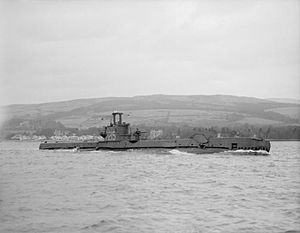 Sceptre underway soon after completion
| |
| History | |
|---|---|
| Name | Sceptre |
| Ordered | 23 January 1940 |
| Builder | Scotts Shipbuilding and Engineering Company, Greenock |
| Laid down | 25 July 1940 |
| Launched | 6 January 1943 |
| Commissioned | 15 April 1943 |
| Decommissioned | February 1947 |
| Identification | Pennant number: P215 |
| Fate | Sold for scrap, September 1949 |
| Badge |  |
| General characteristics | |
| Class and type | S-class submarine |
| Displacement |
|
| Length | 217 ft (66.1 m) |
| Beam | 23 ft 9 in (7.2 m) |
| Draught | 14 ft 8 in (4.5 m) |
| Installed power |
|
| Propulsion |
|
| Speed |
|
| Range |
|
| Test depth | 300 ft (91.4 m) |
| Complement | 48 |
| Sensors and processing systems |
|
| Armament |
|
HMS Sceptre (P215) was a third-batch S-class submarine built for the Royal Navy during World War II. Completed in April 1943, she spent the majority of her career in the North Sea, off Norway. After an uneventful patrol, the submarine participated in Operation Source, an attack on German battleships in Norway using small midget submarines to penetrate their anchorages and place explosive charges. However, the midget submarine that she was assigned to tow experienced technical difficulties and the mission was aborted. During her next four patrols, Sceptre attacked several ships, but only succeeded in severely damaging one. She was then ordered to tow the submarine X24, which was to attack a floating dry dock in Bergen. The operation, codenamed Guidance, encountered difficulties with the attacking submarine's charts, and the explosives were laid on a merchant ship close to the dock instead. The dock was damaged and the ship sunk, and X24 was towed back to England. Sceptre then conducted a patrol in the Bay of Biscay, sinking two German merchant ships, before being reassigned to tow X24 to Bergen again. The operation was a success, and the dry dock was sunk.
After a last patrol in which she sank one ship, Sceptre underwent a lengthy refit to serve as a high-speed target submarine for training purposes. When the war ended, the submarine continued training operations, and was sold for scrap in September 1949.